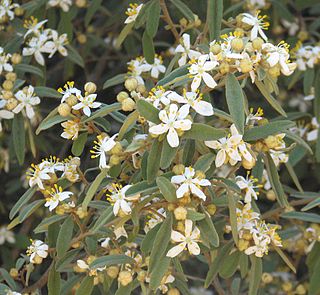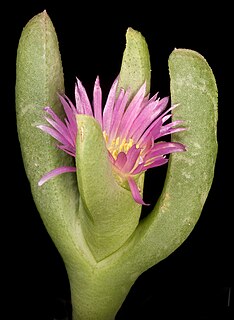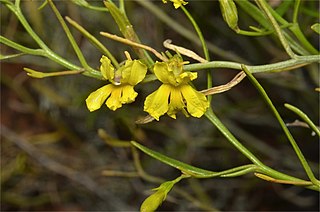
Eucalyptus delegatensis, commonly known as alpine ash, gum-topped stringybark, white-top and in Victoria as woollybutt, is a species of tree that is endemic to southeastern Australia. It has a straight trunk with rough, fibrous to stringy bark on the lower half of the trunk, smooth white bark above, lance-shaped to curved adult leaves, flower buds in groups of between seven and fifteen, white flowers and barrel-shaped or hemispherical fruit.

Pandorea is a genus of nine species of flowering plants in the family Bignoniaceae and is native to Australia, Malesia, New Guinea and New Caledonia. Plants in the genus Pandorea are mostly woody climbers with imparipinnate leaves arranged in opposite pairs, flowers in groups with tube-shaped flowers, and winged seeds.

Pandorea jasminoides, also known by the common names bower of beauty and bower vine, is a species of flowering plant in the family Bignoniaceae and is endemic to eastern Australia. It is a woody climber with pinnate leaves that have three to nine egg-shaped leaflets, and white or pink trumpet-shaped flowers that are red and hairy inside. It is also grown as an ornamental.

Asterolasia is a genus of seventeen species of erect or prostrate shrubs in the family Rutaceae, and is endemic to Australia. The leaves are simple and arranged alternately, the flowers arranged in umbel-like groups on the ends of branchlets or in leaf axils, usually with five sepals, five petals and ten to twenty-five stamens. There are seventeen species and they are found in all Australian mainland states but not in the Northern Territory.

Grevillea arenaria is a shrub which is endemic to the east of New South Wales in Australia. It has an erect to spreading habit and grows to between 1 and 3 metres in height. Its leaves are 1.5 to 7 cm long and 3 to 15 mm in width. The flowers, which occur in groups of 2 to 10, are pink, red or orange, with green or yellow at the base and green styles. These occur year-round, with a major flourish in spring.

Pandorea pandorana, commonly known as the wonga wonga vine or wonga-vine, is a species of flowering plant in the family Bignoniaceae and is native to Australia, Malesia and the southwestern Pacific region. It is a woody scrambler or climber with pinnate leaves, juvenile leaves differing from those of mature plants. The flowers are tubular or funnel-shaped and white with purple markings and the fruit are capsules containing winged seeds. It is easy species to germinate and is a popular garden plant. Common cultivars include the yellow-flowered P. 'Golden Showers', the white-flowered P. 'Snowbells', and the pinkish P. 'Ruby Belle'. The wood was used in making spears for woomeras in the Central and Western deserts.

Goodenia hederacea, commonly known as forest goodenia or ivy goodenia, is a species of flowering plant that is endemic to eastern Australia. It is a prostrate to ascending, perennial herb with linear to elliptic or round leaves, and racemes of yellow flowers.
Amaranthus grandiflorus is a species of Amaranthus found in Australia.
Pandorea baileyana, commonly known as large-leaved wonga vine, is a species of flowering plant in the family Bignoniaceae and is endemic to eastern Australia. It is a woody climber with pinnate leaves that have seven to nine egg-shaped leaflets, and relatively small cream-coloured flowers that are pink inside.

Chenopodium desertorum, common name frosted goosefruit, is a species of flowering plant in the family Amaranthaceae, indigenous to Australia where it is found in all mainland states.
Hibbertia crispula, commonly known as Ooldea guinea flower, is a species of flowering plant in the family Dilleniaceae and is native to disjunct locations in Western Australia and South Australia. It is a small, wiry, glabrous shrub with needle-shaped leaves and yellow flowers with twenty-five to thirty-five stamens arranged around three glabrous carpels.

Sarcozona, commonly known as pigfaces, is a genus of two species of flowering plants in the family Aizoaceae, both species endemic to Australia. They are small, erect or low-lying, succulent perennials with leaves that are triangular in cross-section and arranged in opposite pairs, and daisy-like flowers with twenty to eighty petal-like staminodes and up to 150 stamens.
Goodenia anfracta, commonly known as zig-zag hand-flower, is a species of flowering plant in the family Goodeniaceae and is endemic to central Australia. It is a prostrate or low-lying shrub with linear and lance-shaped to egg-shaped leaves, small racemes of yellow flowers with small, leaf-like bracteoles at the base, and more or less spherical fruit.

Goodenia lunata, commonly known as stiff goodenia, is a species of flowering plant in the family Goodeniaceae and is endemic to inland Australia. It is a ascending or low-lying herb with linear to egg-shaped leaves, small racemes of yellow flowers, and more or less spherical fruit.

Goodenia modesta is a species of flowering plant in the family Goodeniaceae and is endemic to central Australia. It is an erect perennial herb with leaves lance-shaped in outline at the base of the plant, and racemes or thyrses of yellow flowers.

Goodenia vernicosa, commonly known as wavy goodenia, is a species of flowering plant in the family Goodeniaceae and is endemic to South Australia. It is an erect shrub with sticky, later varnished foliage, elliptic to lance-shaped, sometimes toothed leaves and racemes or thyrses of yellow flowers.

Dillwynia uncinata, commonly known as silky parrot-pea, is a species of flowering plant in the family Fabaceae and is endemic to southern Australia. It is an erect, spreading shrub with cylindrical leaves and yellow flowers with a red centre.

Hibbertia paeninsularis, commonly known as peninsula guinea-flower, is a species of flowering plant in the family Dilleniaceae and is endemic to south-eastern South Australia. It is a small, low shrub with few branches, linear to lance-shaped leaves and yellow flowers with six to eight stamens joined at the base on one side of two carpels.
Pandorea floribunda is a species of flowering plant in the family Bignoniaceae and is endemic to eastern Australia. It is similar to Pandorea pandorana but the leaflets are egg-shaped, 30–80 mm (1.2–3.1 in) long and 15–50 mm (0.59–1.97 in) wide and the flowers are pale yellow to cream-coloured.
Pandorea linearis is a species of flowering plant in the family Bignoniaceae and is endemic to Queensland. It is similar to Pandorea pandorana but has nine to thirteen linear leaflets, the lateral leaflets 11–42 mm (0.43–1.65 in) long and 1.5–6 mm (0.059–0.236 in) wide.














